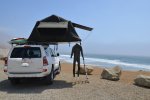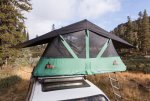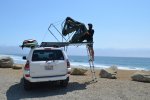Lemsteraak
Adventurer
Boxrocket, I agree, you are on the right track. I don't really mean to hijack this tread as it is about Yakima's tent and innovation but this discussion does have some relevance. One of the things that was stated earlier is that Yakima is re-inventing the mounting system. This is because they weren't part of the original discussion and we designed our equipment to work with their competitor's products. Now I know I'm talking old history and Yakima is a very different company today, but it does serve as a lesson. to collaborate and encourage new idea.
I think the best innovations come from collaboration. I believe that your new hard shelled tent would benefit with input from other sources. Your tent is similar to a tent that Zifer produced in the 90's that is now discontinued, a variant of the Maggiolina called the Adventure. It was boxy and quite flat with an integrated storage rack on top. The world has moved on, that tent was the gold standard for expedition tents in its day but vehicles have advanced and it is now an obsolete design.
Tepui is in the perfect place to collaborate with some of the finest designer and composite experts. Bill Lee, of Santa Cruz, is the first person I would talk to. He revolutionized racing sailboats 40 years ago and his designs are still wining races. Unfortunately we recently lost George Olson, but his compatriot Ron Moore is in Watsonville is an expert in composite construction. Larry Tuttle is also in Watsonville and is who the sailboat racing world talks to for hydrodynamics. Ballenger Spar is also in the same town and are experts in alloys and aluminum. I could go on but you get the idea.
Industry also can be a great resource to confirm your design. For example, Hummer handled crash testing our tents, there was no way we could do that ourselves but they were happy to test the concept and get back to us with ideas for improvements. So, Yakima will have to do all this on their own because they are re-inventing the mount system.
One thing that you excel in is bringing your customers into the fold. You gain their input and insights for free, and this advice has great value. Yakima will not have the benefit of this and it will take them time to overcome this advantage you have developed.
I think the best innovations come from collaboration. I believe that your new hard shelled tent would benefit with input from other sources. Your tent is similar to a tent that Zifer produced in the 90's that is now discontinued, a variant of the Maggiolina called the Adventure. It was boxy and quite flat with an integrated storage rack on top. The world has moved on, that tent was the gold standard for expedition tents in its day but vehicles have advanced and it is now an obsolete design.
Tepui is in the perfect place to collaborate with some of the finest designer and composite experts. Bill Lee, of Santa Cruz, is the first person I would talk to. He revolutionized racing sailboats 40 years ago and his designs are still wining races. Unfortunately we recently lost George Olson, but his compatriot Ron Moore is in Watsonville is an expert in composite construction. Larry Tuttle is also in Watsonville and is who the sailboat racing world talks to for hydrodynamics. Ballenger Spar is also in the same town and are experts in alloys and aluminum. I could go on but you get the idea.
Industry also can be a great resource to confirm your design. For example, Hummer handled crash testing our tents, there was no way we could do that ourselves but they were happy to test the concept and get back to us with ideas for improvements. So, Yakima will have to do all this on their own because they are re-inventing the mount system.
One thing that you excel in is bringing your customers into the fold. You gain their input and insights for free, and this advice has great value. Yakima will not have the benefit of this and it will take them time to overcome this advantage you have developed.




